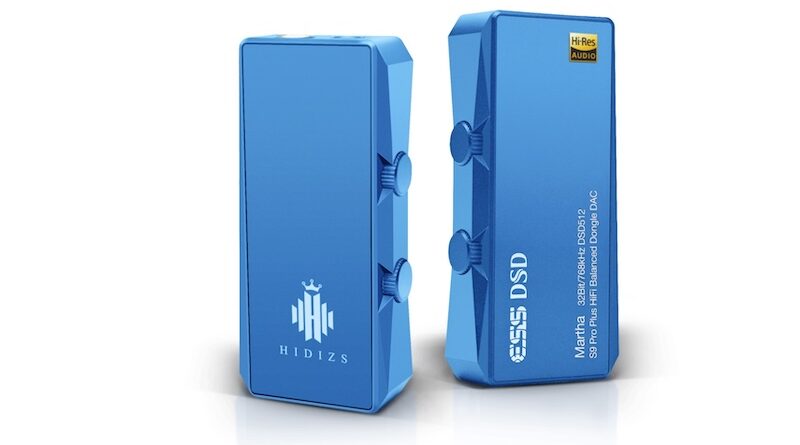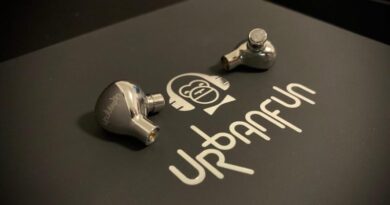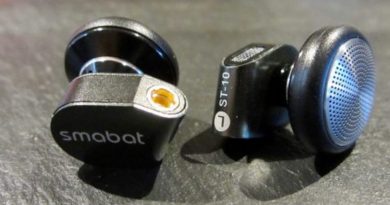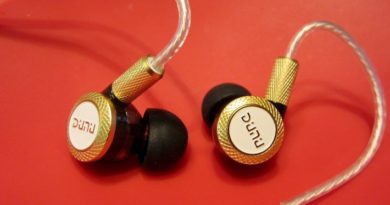Hidizs S9 Pro Plus Martha Balanced & Single-ended Dac/Amp Review – Metal Machine Music, Vol 2
Hidizs sent me the S9 Pro Plus at the same time as its SD2 (review here), which like Hidizs’s prior S9 and S3 dongles hews close to Hidizs’s “house sound”—an energetic, bright, tonality with lean, chiseled notes and a wide soundstage. The, however, S9 Pro Plus is a completely different beast In terms of both sound signature and feature set.
Unlike the stubby, cable-less SD2, the bespoke aluminum-and-glass S9 Pro Plus utilizes the same traditional cabled design as its S9 forbearers, but adds volume buttons which allow for much finer adjustments than most source’s volume control and which double as selectors for six different digital filters (fast roll-off, linear phase slow roll-off etc.).
Both sampling rate and filter effects are indicated by colored lighting, which is a nice aesthetic bonus. As with most such gimmicks, the filters on the S9 Pro Plus have a very small (but audible) effect on the presentation, with the “slow” settings showing less ringing and more rounded treble. Ultra hirez PCM and DSD support is provided, though curiously no MQA, which seems to be a dying breed.
Prior reviews of the S9 Pro Plus have stressed its considerable driving power and inclusion of a balanced (4.4m) out, and it certainly is a lusty beast—even through the single-ended out IEMs of average sensitivity sounded loud at 33% of my Pixel 6’s volume, while (other than losing a little subbass depth and tightness) the 300 ohm/97dB Senn HD 600 didn’t break a sweat when played through the balanced out.
For all that, careful pairing is advised—unlike the S3, the S9 Pro Plus did not match well with very sensitive IEMs like the BGVP DM8 or the KZ ZS10 Pro, which sounded edgy/strident at the high end, especially at higher volumes. In general, the S9 Pro Plus seemed to play better with higher impedance (>50 ohm) phones. Note, too, that if battery life is a priority, the Plus is very power-hungry and will get warm with use.
The Plus uses an ESS DAC chip which imparts a very different signature to the Plus—in contrast to the brightness, forwardness and lean note texture of the its progeny, the S9 is less adrenalized (though not exactly laid-back), with a neutral-to-slightly warm timbre and a thick, but still-crisp note texture. Bass has considerable depth and emphasis, mainly in the subbass region, but remains tight.
Where the SD2, which image very well and present a lot of space between performers, imparted a “bigness” to the music, the S9 Pro Plus sounds simply massive—upright bass has a resonance and body you won’t hear with lesser pieces, while snare drums have a booming-but-realistic snap. Unlike, say, the Moondrop Dawn, overall coloration isn’t wholly absent, but is considerably less on the Plus and there’s little of the digital sheen you’ll hear on the S9 or SD2.
Resolution and transparency are very, very good—little nuances like the quiet guitar echoes and cymbal taps on INXS’s “Need You Tonight” are revealed in a way I’ve never heard before, while the unadorned piano on Keith Jarrett’s “Koln Concert” sounds eerily lifelike. Other than some hiss on very sensitive phones, background noise is wholly absent.
Yet unlike the similarly revealing SD2, the S9 Pro Plus avoids sounding clinical or excessively detailed, and coherence is almost flawless, and you can pick out different performers without losing focus on the musical whole. Which is not to say they’re particularly smooth or mellow—they still retain a hint of Hidizs’s characteristic sharpness/metallic edge at the highest frequencies, and treble-averse listeners might find it slightly hot, but for most of us it’s an appealing, very detailed presentation.
Nominally $139, the S9 Pro Plus is selling for $89 on the Hidizs website, which is only a few sou more than Hidizs’ less powerful models and actually cheaper than the (non-Plus) S9. Especially considering its build quality, flashing lights and fancy tech specs, this seems like good value. Again, it doesn’t achieve the purist’s audiophile-neutral ideal, and you’ll need to be careful with impedance matching, but the S9 Pro Plus plays at a significantly higher level than its cheaper peers and gets my gushing praise.
Disclaimer—yet another freebie from Hidizs—get one here: https://www.hidizs.net/
Specifications Hidizs S9 Pro Plus Martha
| Dimensions: 55×25×11mm DAC Chip: ESS9038Q2M DSD: Native DSD64/128/256/512 PCM: Support up to 32bit/768kHz Outputs: single-ended 3.5mm and balanced 4.4mm plug earphones Sampling rate indicator: Red (PCM 44.1-48kHz), Blue (PCM 88.2-384kHz & DSD) Shell material: CNC integrated aluminum alloy Functionaliy Buttons: 2 Switching Filters: supported Transmission Interface: USB Type-C Supported Systems: Android, Windows, Mac OS, iPad OS, Harmony OS (Please note: a Lightning to Type-C cable with OTG function has to be purchased separately to support iOS) Net Weight: 17 g Color Options: Black, Sliver, Blue Audio Parameters: Test Conditions @32Ω Load Frequency Response: 20Hz-40kHz Distortion: PO (3.5): 0.0019%, BAL (4.4): 0.0008% Signal-to-noise ratio: PO (3.5): 123dB, BAL (4.4): 120dB Separation: PO (3.5): 75dB, BAL (4.4): 115dB Output power: Up to 138mW+138mW SE 3.5mm; Up to 180mW+180mW BAL 4.4mm Packing list: Type-C to Type-C Cable×1, Type-C to USB-A adapter×1, User manual×1, Warranty card×1Dimensions: 55×25×11mm DAC Chip: ESS9038Q2M DSD: Native DSD64/128/256/512 PCM: Support up to 32bit/768kHz Outputs: single-ended 3.5mm and balanced 4.4mm plug earphones Sampling rate indicator: Red (PCM 44.1-48kHz), Blue (PCM 88.2-384kHz & DSD) Shell material: CNC integrated aluminum alloy Functionaliy Buttons: 2 Switching Filters: supported Transmission Interface: USB Type-C Supported Systems: Android, Windows, Mac OS, iPad OS, Harmony OS (Please note: a Lightning to Type-C cable with OTG function has to be purchased separately to support iOS) Net Weight: 17 g Color Options: Black, Sliver, Blue Audio Parameters: Test Conditions @32Ω Load Frequency Response: 20Hz-40kHz Distortion: PO (3.5): 0.0019%, BAL (4.4): 0.0008% Signal-to-noise ratio: PO (3.5): 123dB, BAL (4.4): 120dB Separation: PO (3.5): 75dB, BAL (4.4): 115dB Output power: Up to 138mW+138mW SE 3.5mm; Up to 180mW+180mW BAL 4.4mm Packing list: SD2×1, Type-C to USB-A adapter×1, Lightning to Type-C cable, User manual×1, Warranty card×1 |









